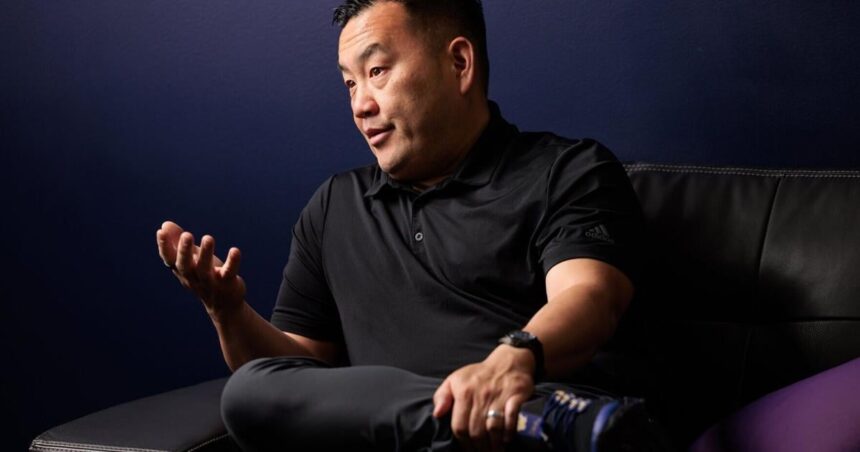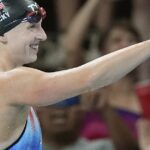SEATTLE — Pat Chun understands the frustrations. He’s heard the complaints about the direction college athletics — and specifically football — is headed.
The college athletics of 2024 are a far cry from what Chun watched growing up as a kid in Northeastern Ohio, Washington’s new athletic director admitted. It’s more transient now. The move he just made across the Cascades from the Palouse to Montlake, might’ve been unthinkable in the past.
But this is a new era. Coaches head wherever the wind takes them. Universities desert century-long rivalries. Student-athletes have more agency than ever. And Chun is the one who will lead Washington into the great beyond.
“There’s another chapter of Washington athletics that needs to be written,” he said on July 2. “We’re charged with being the authors of that chapter because our student-athletes are the ones we have to put in positions to go compete and perform. We take that responsibility with the utmost seriousness.”
People are also reading…
Washington officially joins the Big Ten on Friday, moving conferences for the first time since 1916 when the Huskies were charter members of the Pacific Coast Conference, a Pac-12 predecessor.
Chun, hired on March 26 after spending the past six years as the athletic director at Washington State University, recognizes the challenges facing UW in the Big Ten, yet he said he believes it is the right step for the Huskies going forward.
“Washington as an institution, whether it knows it or not, is a Big Ten institution,” he said. “Washington has more in common with the other Big Ten schools than the eight other Pac-12 schools that aren’t going with the four to the Big Ten.”
Washington certainly faces a fair share of trials. Former Utah athletic director Chris Hill’s blueprint for successful conference realignment had three requirements: investment, university alignment and coaching stability. UW doesn’t stack up particularly well in any of the three categories.
UW will receive half shares of the Big Ten’s media rights until 2030, when the conference will renegotiate its contract. Chun projected $30 million in one-time realignment costs during a presentation to the school’s Board of Regents on June 13, requiring the athletic department to borrow $20 million from Fox Sports and the Big Ten against its future shares as fully fledged members of the conference.
The athletics department requested a loan from the school’s capital assets pool, liquidation of its unrestricted investments in the university’s Consolidated Endowment Fund and a waiver for its financial stability plan regarding the repayment of loans to UW’s internal lending program for the renovation of Husky Stadium and Husky Ballpark. The department still owes around $240 million to the university.
It made interest-only payments just below $10 million per year during the 2023 financial year and requested to do so again while submitting its 2025 operating budget, which was approved. Information for the 2024 financial year is not currently available. Chun said everything the athletic department has done since he’s arrived has been in collaboration with university leadership.
“Everybody understands what’s at stake with college athletics,” he said. “We have not made, nor will we make decisions in a vacuum. We’ll work with our great partners on campus and find solutions to keep this athletic department moving forward.”
Washington is also in need of more funds. Chun said the Huskies had some of the Pac-12’s premier facilities, but are behind when compared to the rest of the Big Ten. He emphasized this is because the Pac-12’s old media rights deal limited the investment all the former Pac-12 schools were able to make, not just Washington. UW will seek to address these needs through philanthropy, Chun said.
“We recognize that there is an unending investment in terms of the things you can deliver for your student-athletes,” Chun said, “and facilities are a piece of that.”
The House settlement, however, might shelve any immediate thoughts about improving facilities. The NCAA recently agreed to settle three antitrust lawsuits brought by former student-athletes, paving the way for revenue sharing between universities and student-athletes among other stipulations. Final rulings are still awaited, but the power conferences and the NCAA have already approved the settlement, which may take effect before the 2025 season.
Hill and TCU athletic director Jeremiah Donati mentioned the upcoming prospect of revenue sharing as the biggest conversation in the collegiate sports world.
Washington is already having discussions about how to potentially implement revenue sharing, Chun said. He added the Huskies have always been dedicated to providing top-tier benefits to its student-athletes, and the approach will not change if the settlement is approved. He did not directly say Washington will participate in revenue sharing at the highest level, though he did not specifically rule it out either.
“We’ll have to take a fine-toothed comb to look at how we’re set up and how we’re structured,” Chun said, “and really think — short term and long term — about how we’re setting ourselves up for success.”
While Chun braces for the House Settlement and other changes that come with Washington’s move to the Big Ten, he’s trying to build his relationship with football coach Jedd Fisch, who was hired on Jan. 14 to replace the Alabama-bound Kalen DeBoer, too.
The athletic director who hired Fisch, Troy Dannen, spent just five months at Washington before bolting for the same job at Nebraska.
Chun said he doesn’t judge coaches based on whether he was the one who hired them. He praised the work Fisch has already done salvaging the 2024 roster and recruiting for 2025 as “impressive.”
The UW athletic director also said he’s taking a patient approach to UW’s football success. He said he won’t make short-term choices that will compromise the program’s larger vision, though he appreciated Fisch’s high standards and goals. Both Chun and Fisch stressed the importance of sustainable, long-term growth.
“We’re in it for the long haul together,” Fisch said at Big Ten media days on July 25. “I have a seven-year contract here. So as we’re building this program, we want to build it in a manner that we can have sustained success, and that’s going to be as a great partner.”
Hill’s final key to successfully moving conferences was university alignment. Washington president Ana Mari Cauce will step down after her second term ends in 2025, but Chun said she was very transparent about her retirement timeline with him during the hiring process.
He called Cauce an “advocate” for UW’s student-athletes and credited her leadership for the past decade for some of Washington’s athletic successes. Chun also said the Board of Regents has communicated where they see athletics fitting into the wider scope of the university, and recognize its importance to the greater campus community.
Hill’s campus alignment also included holding onto other coaches while football tried to compete. Washington already lost baseball coach Jason Kelly, who departed to become a pitching coach for Texas A&M, and gymnastics coach Jen Llewellyn, who took the same job at Iowa.
Chun moved quickly to replace them. He hired former Iowa assistant Jessa Hansen Parker as Llewellyn’s successor, then secured Eddie Smith, a baseball coach with deep Pacific Northwest ties who originally hails from Olympia.
“Our goal,” he said, “is to find the best coach humanly possible in the marketplace for our student-athletes, that fit the university and can win with everything this university has to offer.”
Hill, for his part, said he’s “optimistic” about Washington’s ability to adapt to the Big Ten. He said UW’s large, loyal fan base combined with the Seattle market means the Huskies have the potential to keep up with the schools at the highest levels of investment in college football.
Donati added the jump from the Pac-12 to the Big Ten will likely be less significant than moving to the Power Five from the Group of Five like Utah and TCU. Chun said it will simply come down to how well Washington can adapt, something he said UW has done well in the past and will have to do again as the college athletics landscape continues to evolve.
“There’s more change on the horizon,” he said. “The velocity of change is as fast as it’s ever been. And it’ll probably only continue to get faster. I think for anything, when you look at schools that have had long-term success like Washington, it’s always hinged somewhat on our ability to adapt to whatever the environment is dictating to us.”





